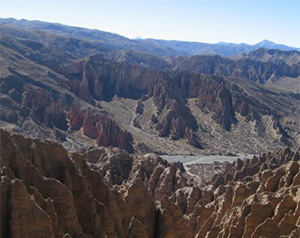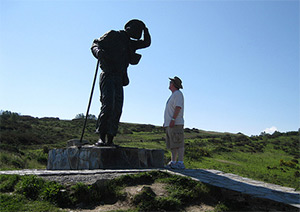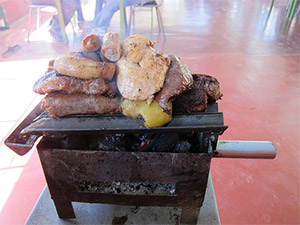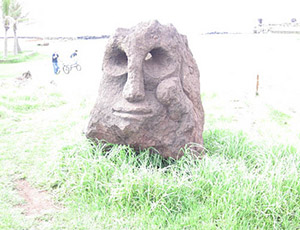By and large, I had a good trip through South America – more specifically southern Bolivia, northern Chile and Easter Island, although its start was not very auspicious.
Either my travel company or the air company LAN had made a mistake, and so there was no gluten free meal arranged between Madrid and Santiago de Chile, a fifteen hour flight. Although I noted the omission many hours before departure, LAN officials stated that they needed at least a day to arrange a gluten free meal.
 Southern Bolivia. Courtesy of Kaksisa Kobayashi
Southern Bolivia. Courtesy of Kaksisa Kobayashi
Upon arrival in Madrid (with a sorry Iberia flight where the only gluten free item available was a small cup of yoghurt), the flight to Santiago turned out to be delayed with almost a day. We had to spend the night in an airport hotel in Barajas, Madrid, more than an hour by tube from the centre of Madrid.
Fortunately, the Hotel Melia (Avenida de Logrones 305) did serve gluten free meals, with nice warm g.f. bread. Moreover, I was able to buy additional gluten free bread in a pharmacy (Farmacia Farmarosa, C. Alanis 7) near the hotel, a rare opportunity in my travels abroad. It was my first experience in Spain after turning celiac, and it certainly was a good one.
Notwithstanding the long delay, LAN was still not able to arrange for a g.f. meal. It now claimed they needed to know at least two days beforehand (later, my travel company showed me papers that indicated that LAN had been notified more than 6 weeks earlier).
Even so, I was served a little food on the plane (fruit, omelet), and I carried a few slices of bread in my hand luggage. Fortunately, on subsequent longer flights, including that to Easter Island, LAN did arrange for g.f. food.
Arriving in Chilean customs with gluten free food
In Santiago de Chile, the customs were decidedly not happy with the food I had with me. Chile is very protective of its agriculture and farming, and fears the introduction of foreign pests that could harm these. Although pasteurized hard cheese was allowed in principle, all of my cheese was confiscated.
 Chile. Courtesy of Fresco Tours
Chile. Courtesy of Fresco Tours
Apparently, the label was not sufficiently clear concerning the type of cheese involved, while also a certain letter of the Ministry of Agriculture of my country was missing. Customs were not very impressed by my celiac credentials and simply claimed that the Chilean rules did not allow it.
Fortunately, I could hold on to my double packaged and airtight sealed 3 Pauly Schwarzbrot mit Teff stash. This g.f. bread typically lasts for a couple of months. Although it has a slightly bitter taste, it combines very well with cheese.
Not declaring food is certainly no option as trained dogs are used to detect food in your luggage, and all luggage is screened upon entry. Hefty fines are involved if you don’t declare. I had read the website of the Chilean customs before the journey, so the confiscation did not came as a total surprise.
Getting gluten free food in Chile and Bolivia
Both Chile and Bolivia produce suitable gluten free cheese, so I was able to scrape through. In both countries, most middle class hotels, but certainly not all, offer g.f. cheese with breakfast. Many have eggs. Some have fresh fruits, but few have natural yoghurt. Typically, there are no g.f. alternatives for bread.
Concerning lunch and dinner, the Spanish language gluten free restaurant card proved very useful in both countries. Even in Bolivia where celiac disease is hardly known if at all, the restaurant card usually produced the right response.
Chile has a Celiac association Fundación Convivir that issues every few months an updated list of gluten free products. This list is made available on-line. The (non)presence of gluten and other allergens is often referred to on food packages in Chile, but not in Bolivia.
Arriving with a flight from Chile, Bolivian customs were not interested in my food supplies. In Bolivia, grill restaurants (parrillada) tend to have one or more g.f. choices on the menu, although you have to identify these yourself and check whether these are really gluten free.
 Bolivian parrillada grill restaurant.
Bolivian parrillada grill restaurant.
Courtesy of butforthesky.com
Watch out for croutons in the salads; given their frequent appearance, I declined to eat French fries in Bolivia as these might have been fried in the same oil as the croutons. Frequently, quinoa was on offer. Blank potatoes are another good option. Especially, but not only, on safaris, mashed potatoes came out of packages involving lots of gluten.
But meat and fish dishes were frequently prepared without flour or wheat. Beforehand, I had read that soy sauce was often used, but it never was used in dishes I ordered. In Sucre, I took several meals at Florin (Calle Bolivar 567), a restaurant with a European owner that serves good llama brochettes with quinoa; it has also good fish on offer.
Cafe 4060 in Potosi (Hoyos 1) had a safe chateaubriand. I dined several times at restaurant Lithium (Av. Potosi 24) in Uyuni , a small Bolivian town near the justly famous Salar de Uyuni.
To get more insight in the presence of grains with and without gluten, I looked for these in the place where many people buy this – a market. In Uyuni, potatoes and rice were most prominently on stock, while quinoa was also on sale. I noticed just one bag of wheat, but it was a large one.
A popular snack containing wheat is the empanada. No barley or rye was on offer. I noticed many advertisements for quinoa in South Bolivia, and restaurants sometimes carried a sign that they served quinoa. You can buy five varieties of quinoa in shops, but restaurants serve usually just one variety.
From Uyuni, we made a jeep tour through south-west Bolivia. My diet was discussed beforehand with the jeep tour operator, who could not offer guarantees that all would be OK. To be sure, I bought some tins of tuna fish and other supplies.
Somewhat to my surprise, I could usually safely eat vegetables, meat and whole potatoes on the jeep trip. But I did supervise meal preparations in the kitchen, as well as made sure that clean utensils were used in serving my food. Others apparently expected more difficulties, as a Lonely Planet website discussion shows.
Unfortunately, I was not able to retrieve the name of the small jeep company that was employed by my travel agent.
Back in Chile, at the San Pedro de Atacama customs office, the officers hardly took notice of my food declaration, and did not care to confiscate the few slices of cheese I brought from Bolivia. However, all luggage was X-rayed once again.
I dined several times at restaurant La Casona (Caracoles 195), and also had a very good experience at restaurant Adobe (Caracoles 211), where I was able to enjoy the full daily set menu (a clear chicken soup, a meat dish, and an espresso). This certainly felt good.
A number of times, I had ceviche, a tasty dish made from white fish marinated in lime juice; it is prepared without gluten. Often, I had grilled fish or meat. A few times I had llama meat. This tastes more like beef, although it tends to be a bit tougher. Steamed vegetables are usually safe, as are potatoes, quinoa and rice.
Concerning drinks, the popular and heady Pisco Sour cocktail should be drunk without the few brownish drops of angostura on top, as angostura often contains gluten. The Peruvian and Bolivian Pisco Sour comes with angostura, while in Chile angostura drops are usually omitted, but by no means always. Pisco Sour is regarded as the national drink in Chile. I found it quite enjoyable, but it really hits you in the thin air of the Andes.
In Santiago, the grill restaurant Gatopardo, Jose Victorino Lastarria 282, was careful with gluten, and offered good meat and fish choices in an attractive setting.
Reaching Easter Island
At Rapa Nui (Easter Island) I had noted beforehand a small health shop that had some g.f. food at Atamu Tekena. When I visited it, it had g.f. spaghetti and a few more items, but no bread. Again, there were a number of restaurants that served at least one g.f. main course.
 Rapa Nui Sculpture in Easter Island.
Rapa Nui Sculpture in Easter Island.
Courtesy of Mary Madigan
Once, I had dinner with traditional Rapa Nui food at Te Ra’ai. It was baked in an underground oven for hours. This proved to be gluten free, although some of the accompanying salads and so on were not – so the staff informed me.
I particularly enjoyed the cebiche in coco sauce in the excellent restaurant Te Moana (Policarpo Toro, at sea). At restaurant Au bout du monde (Policarpo Toro), the shrimp risotto was OK, but portions were rather small.
Not once I had to return my dish to the cook because of gluten, and not once I left a restaurant hungry after ordering. Nearly always I had a full meal – although on one or two occasions I skipped a minor part of the dish, such as the sauce (which I usually order to be served separately if at all).
In all, I met with few problems in Bolivia, Chile and Easter island and not once I had an allergic reaction.
